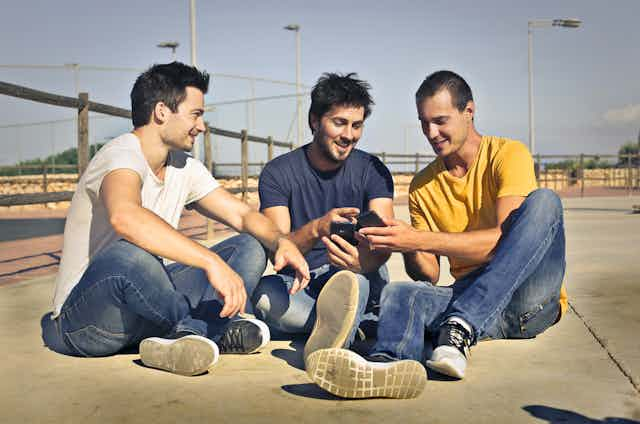If the media is anything to go by, you’d think people who believe coronavirus myths are white, middle-aged women called Karen.
But our new study shows a different picture. We found men and people aged 18-25 are more likely to believe COVID-19 myths. We also found an increase among people from a non-English speaking background.
While we’ve heard recently about the importance of public health messages reaching people whose first language isn’t English, we’ve heard less about reaching young men.
Read more: We asked multicultural communities how best to communicate COVID-19 advice. Here's what they told us
What did we find?
Sydney Health Literacy Lab has been running a national COVID-19 survey of more than 1,000 social media users each month since Australia’s first lockdown.
A few weeks in, our initial survey showed younger people and men were more likely to think the benefit of herd immunity was covered up, and the threat of COVID-19 was exaggerated.
People who agreed with such statements were less likely to want to receive a future COVID-19 vaccine.
Read more: The 'herd immunity' route to fighting coronavirus is unethical and potentially dangerous
In June, after restrictions eased, we asked social media users about more specific myths. We found:
men and younger people were more likely to believe prevention myths, such as hot temperatures or UV light being able to kill the virus that causes COVID-19
people with lower education and more social disadvantage were more likely to believe causation myths, such as 5G being used to spread the virus
younger people were more likely to believe cure myths, such as vitamin C and hydroxychloroquine being effective treatments.
We need more targeted research with young Australians, and men in particular, about why some of them believe these myths and what might change their mind.
Read more: No, 5G radiation doesn't cause or spread the coronavirus. Saying it does is destructive
Although our research has yet to be formally peer-reviewed, it reflects what other researchers have found, both in Australia and internationally.
An Australian poll in May found similar patterns, in which men and younger people believed a range of myths more than other groups.
In the UK, younger people are more likely to hold conspiracy beliefs about COVID-19. American men are also more likely to agree with COVID-19 conspiracy theories than women.
Why is it important to reach this demographic?
We need to reach young people with health messaging for several reasons. In Australia, young people:
are less likely to have symptoms, so they are less likely to meet testing criteria such as having a sore throat, fever or cough
when they do present for testing, are more likely to test positive
are likely to have more social contacts through seeing friends more often or having service jobs. So the potential for spreading COVID-19 is greater, putting extra pressure on contact tracing
can potentially be hospitalised with COVID-19, some with severe complications despite their age.
The Victorian and New South Wales premiers have appealed to young people to limit socialising.
But is this enough when young people are losing interest in COVID-19 news? How many 20-year-old men follow Daniel Andrews on Twitter, or watch Gladys Berejiklian on television?
How can we reach young people?
We need to involve young people in the design of COVID-19 messages to get the delivery right, if we are to convince them to socialise less and follow prevention advice. We need to include them rather than blame them.
We can do this by testing our communications on young people or running consumer focus groups before releasing them to the public. We can include young people on public health communications teams.
We can also borrow strategies from marketing. For example, we know how tobacco companies use social media to effectively target young people. Paying popular influencers on platforms such as TikTok to promote reliable information is one option.
Read more: Most adults have never heard of TikTok. That's by design
We can target specific communities to reach young men who might not access mainstream media, for instance, gamers who have many followers on YouTube.
We also know humour can be more effective than serious messages to counteract science myths.
Some great examples
There are social media campaigns happening right now to address COVID-19, which might reach more young men than traditional public health methods.
NSW Health has recently started a campaign #Itest4NSW encouraging young people to upload videos to social media in support of COVID-19 testing.
The United Nations is running the global Verified campaign involving an army of volunteers to help spread more reliable information on social media. This may be a way to reach private groups on WhatsApp and Facebook Messenger, where misinformation spreads under the radar.
Telstra is using Australian comedian Mark Humphries to address 5G myths in a satirical way (although this would probably have more credibility if it didn’t come from a vested interest).
Finally, tech companies like Facebook are partnering with health organisations to flag misleading content and prioritise more reliable information. But this is just a start to address the huge problem of misinformation in health.
Read more: Why is it so hard to stop COVID-19 misinformation spreading on social media?
But we need more
We can’t expect young men to access reliable COVID-19 messages from people they don’t know, through media they don’t use. To reach them, we need to build new partnerships with the influencers they trust and the social media companies that control their information.
It’s time to change our approach to public health communication, to counteract misinformation and ensure all communities can access, understand and act on reliable COVID-19 prevention advice.

